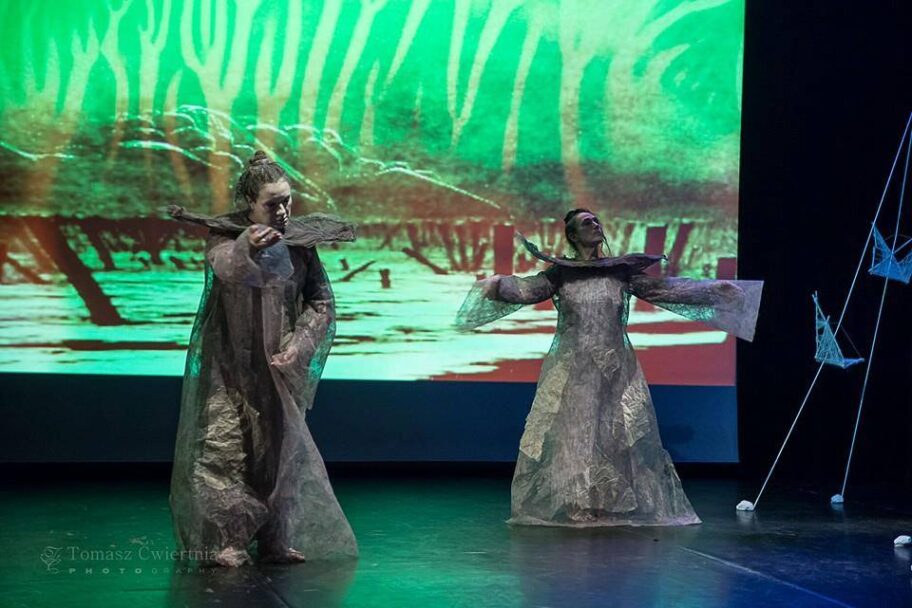
Limen Butoh Theatre “Beksiński_Butoh”, pictured: Sylwia Hanff and Joan Laage. Photo by Tomasz Ćwiertnia

Limen Butoh Theatre “Beksiński_Butoh”, pictured: Sylwia Hanff and Joan Laage. Photo by Tomasz Ćwiertnia
Limen Butoh Theatre was founded by Sylwia Hanff in 2002, as a result of her 10 year theoretical and practical exploration of authentic body language and the essence of physical presence for a performer. Hanff’s theoretical studies concerned Antonin Artaud’s Theatre of Cruelty philosophy, theatrology (mainly theatre of form), anthropology of the body, dance and theatre, as well as other topics. Physical training included Western and Eastern body techniques: ballet, modern and contemporary dance, Hindu dance (bharatanatyam and manipuri), Aztec, African, dance improvisation and body symbolism, pantomime, choreography, nō theatre and martial arts. However, the essence of Henff’s work was not to receive a purely technical education, but to raise consciousness and become able to operate using different energies, overcome limiting technique, liberate the body, and find the source of expression. Meditation practices, aimed at developing a specific type of concentration and careful consciousness of all processes taking part in body and mind, are also important parts of the training of Limen Butoh’s founder.
The most important discovery in the course of her creative research was butoh as a dance, which rejects the safety of techniques and transgresses the everyday body towards liminal experience; experience transcending the division between thought and feeling, body and mind, individual and collective, consciousness and subconsciousness. Butoh is a specific state of being: a perfect presence in which we tell the body to evoke the unknown, not bringing it to the known. As Hanff writes, “it is a dance coming into being from impulses arising inside the butoh-tai (butoh-body)—the dead body, the living body, body-memory—pushing a dancer and the audience into the dark zone, lying beneath the rational order of the world.”
Studying with masters such as Ko Murobushi, Carlotta Ikeda, Daisuke Yashimoto, Atsushi Takenouch, Tadashi Endo, Kan Katsura as well as Yuko Kawamoto, Yumiko Yoshioka, Fran Barbe allowed Hanff to learn the technique of butoh experts: Tatsumi Hijikata, Kazuo Ohno and methods developed by three generations of dancers. All these experiences influenced her individual artistic style. The landmark moment in Hanff’s development as a butoh artist came with her piece Empty Place or the Ocean’s Dreams.
“Butoh is like a virus spreading all over the World. It will become global. People in various countries will internalize it in their own bodies” (Akaji Maro). Limenbutoh t(from limen – Latin “threshold”) is a result of not only spreading the virus, but also searching for the European butoh-body, placed in other historical and cultural contexts.
The Limen Butoh Theatre is comprised of a changing lineup. The company is open to collaboration with artists from different fields, including theater, music and visual arts, which drives an ongoing exchange of creative energy and mutual inspiration. To date, more than 30 artists have participated in the company’s projects, including foreign artists, most of whom have collaborated with Limen Butoh for several years, contributing to its successive performances.
To date, Limen Butoh has produced more than 25 solo and ensemble performances, as well as many etudes and improvisations.
Limen Butoh’s current performances include Wars. The Holy Blood of Dreamers, The Rite of Spring, and The Twilight of Abandoned Cities.
Solo performances are an important part of Hanff’s work, especially on account of the difference between a solo piece, which creates a distilled, intimate situation between the dancer and the audience, and group butoh dance choreographies, perceived mainly as aesthetic images. In solo performances, the intensified presence and the process taking place in the performer’s body-mind is transferred to the viewer, a process that is more difficult to achieve in larger choreographies.
Limen Butoh has performed at many international festivals in Poland and abroad (USA. Japan, France, Holland, Italy, Austria, Latvia).
The company has been featured in two publications: The Body Revolving Stage. New Dance in New Poland by Jadwiga Majewska (Zbigniew Raszewski Theatre Institute, 2011) and in the book Obecni ciałem. Warsztat polskich tancerzy butō by Magdalena Zamorska (Wydawnictwo Libron, 2014), also published in English as Intense Bodily Presence: Practices of Polish Butō Dancers (Peter Lang GmbH, 2018).